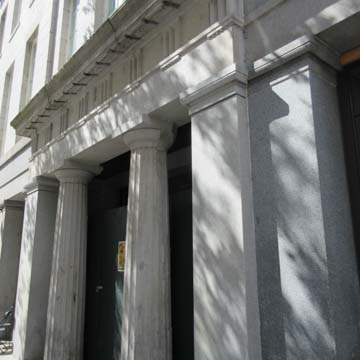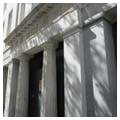This finely proportioned three-story corner building faced with light gray granite originally housed a bank and five stores. Archival drawings indicate that the superb granite Doric portico with fluted columns and a frieze of triglyphs and metopes, as well as the frame of the window directly above it, came from the previous structure on this site, a bank built in 1832 by architects J. Reynolds and J. M. Zacherie. Beginning in the 1830s, granite facings, a fashion said to have originated in Boston, became popular in New Orleans. Here, where subsidence problems usually confine the use of granite to piers at ground level, this building is unusual.
You are here
Commercial Building (New Orleans Canal and Banking Company; Bank of Louisiana)
If SAH Archipedia has been useful to you, please consider supporting it.
SAH Archipedia tells the story of the United States through its buildings, landscapes, and cities. This freely available resource empowers the public with authoritative knowledge that deepens their understanding and appreciation of the built environment. But the Society of Architectural Historians, which created SAH Archipedia with University of Virginia Press, needs your support to maintain the high-caliber research, writing, photography, cartography, editing, design, and programming that make SAH Archipedia a trusted online resource available to all who value the history of place, heritage tourism, and learning.


















